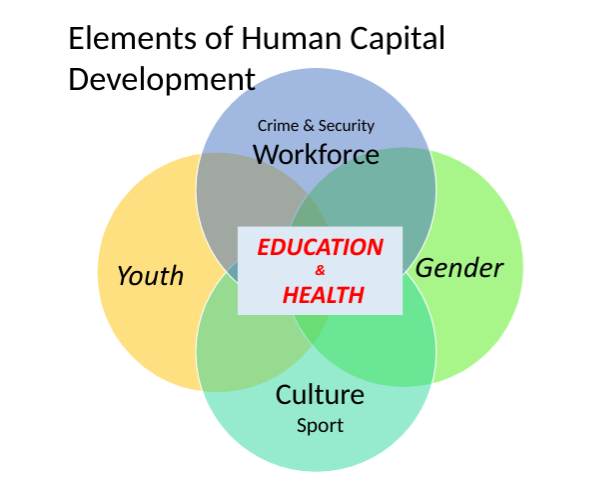 During the Annual Judicial Conference in St Kitts in the week of May 26, 2019, I met with Justice Mario Michel of the Eastern Caribbean Court of Appeal and reminisced about his tenure as Chair of the CARICOM Council of Human and Social Development in 2000 while he was Minister of Education and Culture, St Lucia. We recalled the daring attempt to pioneer an integrated approach to human development for CARICOM under the theme ”Investing in Human Capital with equity". That discussion stimulated this blog and is a tribute to Justice Michel's creative leadership. It is heartening to note that the CARICOM Secretariat and its partners have revived this quest through the Human Resource Development Strategy (2018). The Fourth Meeting of the Council for Human and Social Development (COHSOD) of the Caribbean Community (CARICOM) held in Georgetown, Guyana on 4 October, 2000, deliberated on an initiative for formulating an integrated model of social policy under the theme, "Investing in Human Capital with Equity" The diagram shows, the programme areas of the Directorate of Human and Social Development deemed to be central to Human Capital Development (HCD). The logic for the integrated HCD model was predicated on the assumption of Education and Health as core areas; Culture and Labour/workforce as overlapping; gender and youth as complementary; and Sport, crime and security as intervening. The concept was to project these social policy aspects of functional cooperation in a multidimensional, measurable approach to HCD. The vision was to represent the integrated implementation of these functional areas as vital to the viability of the CARICOM Single Market and Economy (CSME). One practical outcome of the HCD initiative was streamlining the annual work programme of the Directorate of Human and Social Development. Whereas in 2000, there were 54 strategic outcomes among eight programme areas, by 2004, the realignment according to the inter-sectoral matrix -planning approach adopted, resulted in 12 strategic outputs. It is important to note that there continued to be a search for a methodology to operationalize the HCD model. The exercise was taking place at a time when CARICOM and other regions were steeped in the follow up to 1995 World Summit on Social Development, (WSSD) in Copenhagen, the largest gathering of Heads of States and governments up to that time, that resolved to put people at the centre of development. The WSSD was the precursor to the UN Millennium Development Goals (MDGs). Since the eight (8) MDGs established targets that overlapped with the eight (8) CARICOM HCDs, the latter concept while retained and advocated over the next 5 years, was never fully operationalized. It was superseded by the MDGs to which all CARICOM States became committed . https://www.un.org/millenniumgoals/news.shtml At the 32nd CARICOM COHSOD in May, 2018 the Human Capital Development Initiative was revived. The recommendations of the Commission on Human Resource Development (HRD) were accepted under the theme, 'Positioning Human Resource as Central to Caribbean Resilience and Development’. It established strategic priorities for improving access, relevance, equity and quality. It is intended to be a multi-sectoral-people-centered approach to development, in which human development is at the core of sustainable development. Ambassador Irwin LaRocque, CARICOM Secretary General aptly puts it: By mainstreaming HRD, it becomes possible to realize goals related not only to the areas of human and social development, but critically, to our economic development. The enhancement of our human capital is fundamental to the success of the CARICOM Single Market and Economy (CSME)". The CARICOM HRD Strategy converges with the elements of the World Bank's Human Capital Project. It addresses deficiencies at all levels in the education system aimed at ensuring that people of the Region are adequately equipped with 21st century skills and competencies. It is aligned to the CARICOM Strategic Plan aimed at social, economic, technological and environmental resilience. Its elements also relate to targets of the UN Sustainable Development Goal (SDG) #4, which promotes “inclusive and equitable quality education and promotes lifelong learning opportunities for all” and SDG # 8 that promotes “sustained inclusive and sustainable economic growth, full and productive employment and decent work for all. These are in fact the essence of the lessons learned from the World Bank HCP that were the focus of the GOFAD Blog (May 31, 2019) Myrna Bernard , CARICOM Director of Human and Social Development , who was a member of the Commission on HRD (2018) and one of the architects of the HCD (2000) provides a useful summary: https://youtu.be/8SOeoQJbiE8 The CARICOM HRD Initiative, places emphasis also on early childhood development interventions championed by Guyana's First Lady, Sandra Granger that promote nurturing care—health, nutrition, responsive caregiving, security and safety, and early learning. It refers to empirical evidence showing that early childhood programmes may cost as little as 50 cents per child per year, when combined with existing services such as health. And it is supported by the science and economics that are clearly on the side of investing in the first 1,000 days of a child’s life. The cost of not doing so is higher. Children fall behind long before they set foot in school. [Lancet’s Series, Advancing Early Childhood Development: from Science to Scale]. The HRD initiative is concerned that in the CARICOM region there is less public provisioning for early childhood education, especially for the 0-2 year age group, as opposed to the pre-school years. The uneven funding distribution across sectors is striking; expenditure on pre-primary as share of government expenditure on education is only 2.9% compared to primary at 34.9% and 40.3% for secondary education. Research shows that a child’s brain develops faster in the first 2-3 years than at any other time in life. These are the same attributes that are reflected in the Human Capital Project (see GOFAD blog May 10, 2019. ) https://globalonefrontier.org Among the other elements of human capital which CARICOM's HRD actively relates to, is the creation of cultural entrepreneurs for which it has established through CDB, a Creative Industries Innovation Fund (CIIF) facility capitalized at US$2.9M, intended to be a multi-donor fund to encourage innovation, job creation and sustainable capacity-building of the sector. In addition, the CARICOM HRD is complemented by a regional accreditation mechanism for Caribbean Vocational Qualification (CVQ) and the Technical and Vocational Education and Training (TVET) coordinated by Caribbean Association of National Training Agencies (CANTA), designed as an integral part of the common qualification framework, preparing manpower for development across CARICOM. So far, seven CARICOM countries have fulfilled the stringent technical and other competency criteria associated with specific occupations: Jamaica, Trinidad and Tobago, Barbados, St. Lucia, Grenada, Guyana and St Vincent and the Grenadines. The Caribbean Community Secretariat has over time pioneered several programmes of great significance. Most of these are classic examples of how small states can perform with distinction by pooling resources. Others like the human capital initiative and the related human resource development strategy are worthy tools that can transform the Region. The problem remains: moving from concept to reality which in most times is beyond the reach of the technical officers in the CARICOM Secretariat. Solving the implementation deficit is a matter of governance and leadership of member states and of political will at the regional level. Eddie Greene
5 Comments
Laura Longsworth
6/6/2019 04:50:41 pm
Thank you for sharing blig on HRD.
Reply
Garfield Barnwell
6/7/2019 03:33:22 am
The blogs raise several interesting scenarios in the determination of the path to development. Highlighting the strategic importance of the linkages between education, and health and human progress from the various dimensions of the UN 2030 development agenda they provide development practitioners with crucial insights on the significance of the international development agenda. Most studies and official reports stress that increased productivity is the most effective way in stimulating and enhancing sustained growth.
Reply
Edward Greene
6/7/2019 04:02:34 am
This is specifically in response to Laura Longsworth. The Rate of return (ROI to education cannot be underestimated in planning HRD strategies The latest I have come across for the Caribbean as a whole is that which was used in Alister Mc Intyre’s 10 year development plan for University of the West Indies (1994) However the World Bank Human Capital Project (2018)shows that the global rate of ROI in schooling is approximately 10 percent for primary education, five percent for secondary education and 16 percent for university education. Social ROI of education for the world is 18.9 percent for primary education, 13.1 percent for secondary education and 10.8 for higher education. In addition , private ROI of education for the world is 26.6 percent for primary education, 17 percent for secondary education and 19.0 for higher education. I will explore further references but others may assist
Reply
10/11/2021 08:02:44 pm
The primary troubles with gold bullion are that the storage and coverage costs and the distinctly large markup from the dealer each hinder earnings capability.
Reply
Leave a Reply. |
Details
AuthorEdward and Auriol Greene Directors, GOFAD. Archives
April 2022
Categories |
Global Frontier Site Links |
Contact InformationEmail: [email protected]
Twitter: @GofadGlobal |

 RSS Feed
RSS Feed
